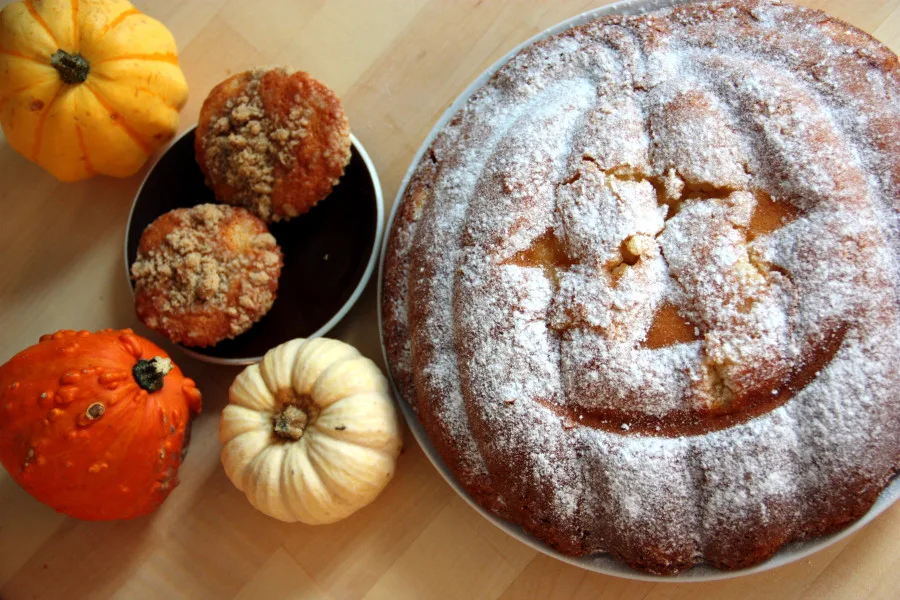
Squeeze more out of your squash with these pumpkin tips
Most of us use pumpkin in just a handful of dishes, but this vegetable has far more dexterity than we give it credit for. Raw, pickled, fried, mashed, sweet and savoury - basically anything goes with pumpkin. Here are some of the best ways to branch out.
Berlin (dpa) - October is Halloween month, and that means pumpkins are everywhere.
It's not only Jack-o'-lanterns sitting on front steps and window sills; supermarket shelves and market stalls are also stacked with vibrant squash in various shapes and shades.
There are several hundred edible varieties of pumpkin, but in most Western supermarkets, butternut squash and Hokkaido pumpkin are the most common.
SEE ALSO: How to pick the perfect pumpkin
Pumpkin is an incredibly versatile vegetable and lends itself to many more dishes than just the ordinary—though very delicious—soup.
Here are some of our favourite recipes, plus tips on how to best prepare different varieties.
Are all parts edible?
Pumpkins can be divided into three different categories: Those used for their tasty pulp, like Hokkaido, for example, those where only the seeds are used to extract the dark green pumpkin seed oil, and those used for decoration - due to bitter substances they're not suitable for cooking!
With edible pumpkins like Hokkaido, you can also use other components besides the pulp. Try filled blossoms, for example, best picked from your own pumpkin patch. "You can cover them with pancake batter and fry them in a little oil," recommends pumpkin farming specialist Daniela Gamb.

No peeling needed: The best thing about the Hokkaido variety of pumpkin is that you can eat the skin. (Source: Christin Klose/dpa)
SEE ALSO: How severe weather has impacted Halloween over the years
Make sure to only harvest the male flowers without ovaries - recognizable by the long stalk - as the female ones are supposed to become pumpkins.
The skin is usually only edible on summer squash. "Summer pumpkins, especially courgettes, are harvested before they're ripe and still have a soft skin," says Hans-Georg Levin from Germany's Agricultural Information Centre (BZL). Therefore there's no need to peel the vast majority of summer squash.
Winter squash, on the other hand, is harvested later, when the pumpkin has reached its mature stage. At that point, the skin will have hardened into a tough rind which is no longer edible. That is, except for the all-time favourite Hokkaido: Despite being a winter squash, its skin remains soft enough for consumption.
Meanwhile, besides oil production, roasted pumpkin seeds also make for a great snack. Instead of buying them at the supermarket, try using those left over after you make your next batch of pumpkin soup. When roasting them in a frying pan, you can also add some spices.
Are the green spots on pumpkins safe to eat?
"Green spots in pumpkins are no problem," says nutrition specialist Daniela Krehl. The same can't be said of tomatoes and potatoes, however.
Any green spots on these, members of the genus of flowering plants called Solanum, contain the poisonous compound solanine.
Ingesting this can cause symptoms such as nausea, headaches, vomiting, diarrhoea, abdominal pain and neurological problems. In very severe cases, even death can result.
Green spots at the base of a pumpkin's stem or in the pulp are a sign that it's not fully ripe.
WATCH: Nutritionist breaks down everything you can do with these small pumpkins
SEE ALSO: How to keep your kids warm on Halloween without ruining their look
How to properly cut a pumpkin
Many varieties, like Hokkaido, are quite rigid when raw, which makes chopping a little difficult.
Ute Ligges, who runs a pumpkin farm in western Germany, has a tip: "Put it in the oven and pre-cook it a bit, that makes it soft and easier to cut. Ten minutes at 180 degrees Celsius is often enough."
Next, place the pumpkin on a wooden board and cut it with a large, sharp knife.
If you don't like the skin, you can now remove it - with some varieties that's very easy. "Butternut has a very soft skin, so you can use a potato or asparagus peeler," recommends Daniela Gamb's husband Stefan. It's best to cut it into manageable pieces beforehand.
WATCH: Pumpkin carving tips
Which spices are best to season pumpkin?
Most pumpkins' original taste is rather subtle, so adding a good portion of condiments therefore helps to spice things up a little - and don't go too easy on your squash: pumpkins can take stronger spices and the hot stuff.
For a spicy dish, try adding ginger, chilli, curry powder, garlic, paprika, onion, nutmeg and balsamic vinegar, for example, or a combination of some of the above.
If you're preparing sweet pumpkin - and if you haven't tried it, you should! - season with honey, cinnamon or fruit juices or add pineapple, apples or oranges, for example.
The classic of classics: Pumpkin soup
This is a dish that never gets old. Easy to prepare, pumpkin soup is a hearty dish perfect for fresh autumn days.
While many like to use Hokkaido, which has the advantage that you don't need to peel it before cooking, Daniela Gamb prefers Butternut squash whose texture is a little more delicate. Hokkaido sometimes makes the soup a little mealy, she says.
Whichever variety you prefer, here's what you need for four servings - or 2 litres of soup:
500 g pumpkin pulp
1 onion
4 tbsp butter
3/4 l vegetable stock
1/8 l cream
100 g crème fraîche
vinegar
salt
pepper
garlic powder
2 slices of toast
Dice the pumpkin and fry in butter with the sliced onions until golden brown. Pour in the stock and cook for 15 minutes, then puree with a blender. Add the cream and crème fraîche and whisk the soup until frothy.
DON'T MISS: Pumpkin spice is back! Here's why we love it so much
Season to taste with a little vinegar and the spices.
Cut the toast into cubes and toast in butter. Garnish with the toasted bread cubes when serving.
If you'd like to experiment with the taste, try adding some further ingredients, like potatoes, carrots or an apple. Top off your finished soup with some pumpkin seed oil and some freshly chopped chives.
More savoury pumpkin recipes
Pumpkin is an allrounder which doesn't only make for a great soup but can be added to casseroles, fried or barbecued, for example.
If you want to try fried pumpkin, butternut is best, according to Gamb. "Cut it into thin slices and fry it in a pan or on the grill." Lamb's lettuce is a great side dish, topped with walnuts, goat cheese and a vinegar dressing.
WATCH: How to keep critters from feasting on your pumpkin masterpiece
Ute Ligges has a simple recipe for oven pumpkin. You'll need two pumpkins, for example Puccinis or Rolet, 2 tbsp of butter, salt and herbs, like thyme for example.
Halve the pumpkins and remove the seeds with a spoon. Fill with the butter and bake in the oven at 160 degrees for about 25 minutes. Season with salt and herbs before serving.
Another option is to cut the vegetables into wedges and bake at 200 degrees for about 20 minutes to make pumpkin fries. Season with salt and pepper after they're crispy.
Baked spaghetti squash
Why is the spaghetti squash called spaghetti squash? Because it has stringy pulp, which lends itself perfectly to making no-wheat pasta, according to Ligges.
Cut the squash in two halves and remove the seeds. Rub the inside with a little olive oil and fill with Bolognese sauce.
Cover with plenty of grated Parmesan cheese, then put the two halves on a greased baking tray and support them using some tinfoil. Bake for 200 degrees for about 45 minutes.
By the way, you can basically prepare all pumpkin varieties using your microwave, especially Puccini, Rolet, Baby Boo, Delicata and Ivory, says Ligges.
Cut of the top and remove the seeds. Rub the pumpkin with some oil and put in the microwave for 10 minutes at 600 watts. "Fill it with shrimp cocktail or sour cream afterwards," and you'll have a great dish, according to Ligges.
Time for dessert
It might sound counter-intuitive, but pumpkins are also great as a dessert. Ligges likes to make a delicious mousse using 500 ml whipped cream, 125 g Mascarpone, 200 g Crème fraiche, 150g yoghurt, 200 g curd, 1 to 3 tbsp sugar and 3 leaves of gelantine.
Whip the cream until stiff, then mix the rest of the ingredients. Dissolve the gelantine in water and stir in along with the cream. Fill into small glasses.
For the topping, you'll need 500 g of pumpkin pulp - for example Puccini or Autumn Crown -, 80 g sugar, 3 tbsp orange juice, 3 tbsp water, cinnamon, 1 tsp sugar.
Peel and grate the pumpkin, then melt the sugar in a small saucepan. Deglaze with orange juice, add the pumpkin flakes and cook until soft. Add a little water and purée, before seasoning to taste with sugar and cinnamon.
Add 1 tbsp of the topping to the cream in the glasses and voilà - your pumpkin mousse dessert is ready.
By the way, pumpkin is also a great vegetable for making pap as small children tend to like it due to its sweetness.
Pumpkin is a keeper
Many pumpkin varieties can be stored for a long time, but with a few extra tricks you can make it last well into the next year.
Sweet and sour pickled pumpkin is certainly a classic, but preserving is as a jam or chutney also works well.
You can also try fermenting it - "an unopened jar of fermented pumpkin will keep for six months," says cook book author Marcel Kruse.
The most important ingredient: 3% brine, but you can easily make that yourself: For 1 litre, stir 30g of salt into cold water.
Kruse recommends using normal rock salt or sea salt instead of iodised salt.
You'll also need 1 kg of pumpkin, for example Hokkaido, 1 tsp mustard seeds or fennel seeds, 1/2 tsp pink berries or peppercorns, 3 fresh sprigs each of rosemary and thyme, 3 cloves of garlic, 700 ml brine, 1 preserving jar (with a volume of 1.5 l), and something that can be used as a suitable weight.
Dice the raw pumpkin, then place the spices, herbs and garlic in the bottom of the jar. Add the pumpkin cubes, fill with brine and add the weight, for example a saucer or a little bag filled with marbles, on top to make sure the liquid always covers the pumpkin and the spices.
Close the jar and store it - first for a week at room temperature, then in a cooler place for at least a month. Once opened, consume within two weeks.
WATCH: How to pick the perfect pumpkin
(Reporting by: Christina Bachmann. Editing by: Coman Hamilton)









